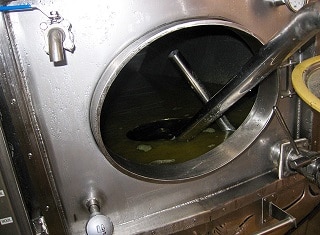Seeing that grapes are the raw material for wine, the juice and solids they contain will play a role in the eventual wine. In the case of white wine considerably less skin contact is applied than for red wine and the solids remaining after skin contact will play an important role.

A racking pipe and plate can be used to separate clear juice from solids.
The extent of juice clarification in white wine making is one of the first resolutions of winemakers. The solid content of white juice influences the alcoholic fermentation and the malolactic fermentation (MLF) as well as the flavour profile of the resulting wine.
The grape characteristics and extraction processes of the grape juice cause a considerable difference in the solid content of the grape juice. Limited information however exists regarding the actual composition of the solids in juice. This causes the resolution concerning its optimal composition to be complicated. The solids of white juice consist of approximately 70% polysaccharides, 8% lipids and 2.5% nitrogen. Minerals, phenolic compounds and pectins contribute the most to the remaining composition. The most grape-based solids have a particle size with a diameter smaller than 2 µm. During alcoholic fermentation the particles become smaller as result of the carbon dioxide movement. After that they tend to flocculate and settle together with the yeast lees.
The solids do however have a considerable influence on fermentation. They supply especially lipids and nitrogen for yeast cell development. Lipids are an important component of the cell membrane, which facilitates the yeast cell to resist alcohol at the end of fermentation. Juice with a high solids concentration usually ferments faster. The same applies to the rate of MLF.
The solids concentration of juice can be expressed as nephelometric turbidity units (NTU), total wet, dry suspended solids or percentage solids. Practically spoken NTU-measurement is the most suitable measurement. Different opinions exist however regarding the most suitable NTU-reading of white juice prior to alcoholic fermentation. In order to ensure that sufficient lipids are available to the yeast. NTU-readings of 50 to 150 are recommended. In the case of clearer juice, oxygen additions can be considered at the end of the yeast growth phase to compensate for the lipid shortage, seeing that yeast can use oxygen to synthesise lipids. Italian research investigated the juice of six different cultivars at NTU-levels, which varied from 15 to 350, to make certain conclusions. More turbidity led to faster fermentations and lower residual sugar concentrations, irrespective of assimilable nitrogen concentrations. A NTU-reading of 100 resulted in the best balance between the appearance of fruity flavours and the absence of sluggish fermentations or reductive flavours.
The concentration of solids in juice influences at least 40 non-volatile and volatile compounds. More turbidity causes lower volatile acid and acetaldehyde concentrations and higher glycerol concentrations. There was also a trend that more solids cause lower esters concentration, but result in higher concentrations volatile sulphur compounds and higher alcohols. This causes a lower appearance of cultivar character. With certain cultivars, the juice with more turbidity results in more polysaccharides, irrespective of the extraction method which was applied. This has an influence on the taste of the wine.
Sometimes there is concern about the potential negative results that too much solids in white grape juice will have on the resulting wine. The most polyphenol oxidase enzymes that cause browning and sulphur spray residues which can cause reductive flavours, occur in the grape skin. The latter is an important source of the solids in juice, which can lead to the mentioned potential negative results in wine. If winemakers are however aware of this and manage it correctly, it should not be a problem (Godden, 2019).
Reference
Godden, P., 2019. Grape solids in white winemaking. Australian and New Zealand Grapegrower and Winemaker, December 2019: 73 – 74.













